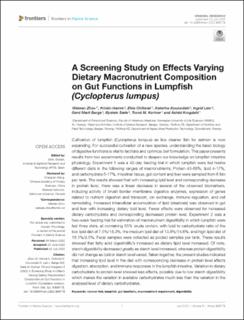| dc.description.abstract | Cultivation of lumpfish (Cyclopterus lumpus) as lice cleaner fish for salmon is now expanding. For successful cultivation of a new species, understanding the basic biology of digestive functions is vital to facilitate and optimize diet formulation. This paper presents results from two experiments conducted to deepen our knowledge on lumpfish intestine physiology. Experiment 1 was a 42-day feeding trial in which lumpfish were fed twelve different diets in the following ranges of macronutrients: Protein 43-68%, lipid 4-17%, and carbohydrate 6-17%. Intestinal tissue, gut content and liver were sampled from 6 fish per tank. The results showed that with increasing lipid level and corresponding decrease in protein level, there was a linear decrease in several of the observed biomarkers, including activity of brush border membrane digestive enzymes, expression of genes related to nutrient digestion and transport, ion exchange, immune regulation, and cell remodeling. Increased intracellular accumulation of lipid (steatosis) was observed in gut and liver with increasing dietary lipid level. Fewer effects were observed for increased dietary carbohydrate and corresponding decreased protein level. Experiment 2 was a two-week feeding trial for estimation of macronutrient digestibility in which lumpfish were fed three diets, all containing 55% crude protein, with lipid to carbohydrate ratio of the low lipid diet of 7.5%/18.3%, the medium lipid diet of 13.8%/14.6%, and high lipid diet of 18.1%/9.5%. Fecal samples were collected as pooled samples per tank. These results showed that fatty acid digestibility’s increased as dietary lipid level increased. Of note, starch digestibility decreased greatly as starch level increased, whereas protein digestibility did not change as lipid or starch level varied. Taken together, the present studies indicated that increasing lipid level in the diet with corresponding decrease in protein level affects digestion, absorption, and immune responses in the lumpfish intestine. Variation in dietary carbohydrate to protein level showed less effects, possibly due to low starch digestibility which makes the variation in available carbohydrates much less than the variation in the analysed level of dietary carbohydrates. | en_US |
